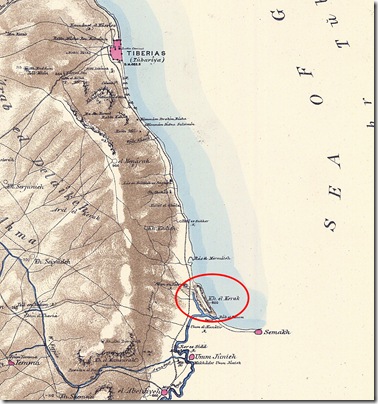Earlier this week, there was a story about the discovery of an Umayyad palace that was previously identified as a synagogue. Early reports contained very few details, but a new story yesterday makes things a bit clearer (HT: Gordon Govier).
The site is still not named, but a little checking around has revealed that it is Khirbet Beth Yerah (Khirbet el-Kerak) on the southwestern shore of the Sea of Galilee (see map below). A synagogue was discovered here in the 1950s by P. L. O. Guy and Pesach Bar-Adon. Current excavations led by Rafi Greenberg of Tel Aviv University now identify the building as an Arabic palace dating to the 7th-8th centuries A.D. How did they get it so wrong?
The palace was also dismantled down to its foundations after the fall of the dynasty, leaving nothing behind but a foundation and few clues to help date the structure.
Archaeologists at the time also believed, erroneously, that the early Arab caliphates did not carry out many large-scale building projects.
Researchers first began to raise doubts about the origins of the structure in the 1990s, but it wasn’t until 2002 that archaeologist Donald Whitcomb from the University of Chicago first suggested that the site might in fact be the missing Umayyad palace. That identification was confirmed by archaeologists this week.
The identification of the structure as a synagogue was based on the image of a menorah that the early excavators found carved into the top of a pillar base. But the scholars behind the new review of the site realized that the carving was a red herring — that surface would have been covered by a pillar in the original structure, so the carving must have been added later.
The article on Beth Yerah in The New Encyclopedia of Archaeological Excavations in the Holy Land (1993) provides more information on the “synagogue”:
Within the area of the Roman fort, Guy and Bar-Adon uncovered the remains of the foundations of a synagogue (22 by 37 m). The building was divided by two rows of columns into a nave and two aisles. There was an apse in the middle of the southern wall, oriented to Jerusalem. The nave was paved with a colored mosaic, partially preserved, depicting plants, birds, lions, and other motifs. Carved on the base of a column were a menorah, lulab, ethrog, and incense shovel (1: 258).
A couple of brief comments. The apse oriented toward Jerusalem also faces Mecca. The mosaic’s depictions might surprise some unfamiliar with Arabic tastes in this period, but it closely resembles the Umayyad palace in Jericho (Kh. el-Mafjar). Apparently the decorated column base threw the original excavators off. (And you thought archaeologists used pottery for dating.)
You can read more about the Tel Bet Yerah Research and Excavation Project at the official site.
